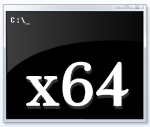20 June 2009 | Programming |
 Let’s say you’ve written a little 32-bit script that calls a Windows command such as
Let’s say you’ve written a little 32-bit script that calls a Windows command such as nbtstat. When you try to run the script in x64 Windows, you get an annoying “File not found” error – even though you can see the command sitting in the \Windows\system32 folder.
What’s going on here?
x64 version of Windows have two system folders: \Windows\system32 and \Windows\SysWOW64.
The 32-bit commands are in the SysWOW64 folder, and the 64-bit commands are stored in the system32 directory. x64 Windows looks in system32 by default when you call a command line function, since it tries to call the 64-bit goodies (no, that’s not backwards!).
So, you might think that you can simply change your script to explicitly call, for example, \Windows\system32\nbtstat instead of just nbtstat, and you’ll be off and running, right? Wrong.
Fortunately, there is an easy way to solve this little problem…
(more…)
16 April 2009 | Programming |
 The jQuery JavaScript library is a seriously beautiful thing. With a code base that is much smaller than Prototype + Scriptaculous, jQuery can be used on a web site do a whole lot of fancy AJAX stuff with syntax that is surprisingly easy.
The jQuery JavaScript library is a seriously beautiful thing. With a code base that is much smaller than Prototype + Scriptaculous, jQuery can be used on a web site do a whole lot of fancy AJAX stuff with syntax that is surprisingly easy.
At first, jQuery doesn’t look easy. In fact, it looks downright scary. But once you actually dive in, you find that the water is warm and inviting indeed!
If you’ve used jQuery, there is undoubtedly one problem you will encounter: How do you insert a delay between special effects like fadeIn() and fadeOut()??
I found several answers to this question on the web, but I decided not to use any of them. Instead, I decided to leverage jQuery’s built-in callback functionality to get a “delay” in one clean, simple, and super easy step. But, as always, there is a catch…
(more…)
2 April 2009 | Programming |
 Say you were using the active_record_store for sessions in Rails 2.2, and you added your own custom column(s) to the default sessions table in your database. You might have done so because you wanted to add, say, the user’s id number to each entry in the sessions table. This would let you do things like quickly and efficiently delete a user’s session.
Say you were using the active_record_store for sessions in Rails 2.2, and you added your own custom column(s) to the default sessions table in your database. You might have done so because you wanted to add, say, the user’s id number to each entry in the sessions table. This would let you do things like quickly and efficiently delete a user’s session.
Unfortunately, when you upgrade to Rails 2.3.2, your session hack will be seriously busted. Cookies will work great, and so will the standard session scheme, but your custom column in the sessions table won’t be updated. Worse yet, you’ll get a lovely error when you do things the old way. The problem is due to 2.3.2’s new “lazy sessions“. In short, unless a session is accessed, it doesn’t load all the session handling stuff. If you don’t want to use sessions, you don’t have to turn them off anymore.
So, that’s great, but your custom sessions table is still broken. There are no solutions posted anywhere that I could find, so I took the liberty of figuring it out myself. Here’s what to do…
(more…)
16 March 2009 | Programming |
 Ruby on Rails has become a rather popular framework that many have used to easily and quickly create some pretty powerful web sites. As with any web programming language or framework, it certainly does have its problems. For example, Rails has never been well-known for its incredibly speedy database layer. In fact, if you’re not careful, you can make a glorious application that will run your server into the ground because of all the heavy behind-the-scenes DB queries.
Ruby on Rails has become a rather popular framework that many have used to easily and quickly create some pretty powerful web sites. As with any web programming language or framework, it certainly does have its problems. For example, Rails has never been well-known for its incredibly speedy database layer. In fact, if you’re not careful, you can make a glorious application that will run your server into the ground because of all the heavy behind-the-scenes DB queries.
Another problem is that a lot of people get their Rails coding tips and tricks from others – basically what you’re doing right now! The solutions you find online aren’t always optimal, and are sometimes downright scary.
Take a custom 404 error page. It’s easy enough to make, but you have to be careful about how you actually implement it.
(more…)
22 February 2009 | Programming |
Say you have an application running on a Linux server using the ext2 or ext3 file systems. You set up a caching scheme in your application to store files like so:
/cache/stamps/1/main_content.cache
/cache/stamps/1/comments.cache
/cache/stamps/2/main_content.cache
/cache/stamps/2/comments.cache
/cache/stamps/3/main_content.cache
/cache/stamps/3/comments.cache
...
Eventually, you’re going to run into a problem: Your caching will stop working since your application won’t be able to write to the “stamps” directory any more. Instead, you’ll get an error message like this:
Couldn't create cache directory: /stamps/41134/main_content (Too many links - /var/www/your-app/tmp/cache/stamps/41134)
At that point, you’ll try to search for “too many links”, and probably you won’t find much information that is actually comprehensible to normal human beings. Fortunately, it really is quite simple to repair once you understand what’s going on.
(more…)
 Let’s say you’ve written a little 32-bit script that calls a Windows command such as
Let’s say you’ve written a little 32-bit script that calls a Windows command such as 

 Say you were using the active_record_store for sessions in
Say you were using the active_record_store for sessions in 

Recent Comments